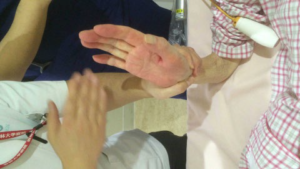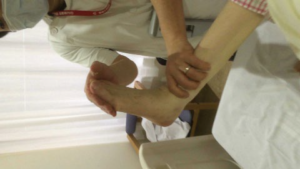BACKGROUND
The diagnosis of acute type 2 respiratory failure needs a multidisciplinary assessment. Among them, physical diagnosis would be a pivotal role for rapid and precise diagnosis
CASE REPORT
A 76 year-old woman was admitted to our hospital with a chief complaint of dyspnea (day 1). She had primary Sjogren’s syndrome with pulmonary involvement (usual interstitial pneumonia) two years previously, and underwent home oxygen therapy for recent three months (only at effort 4 L/min). On admission, vital signs were as follows, blood pressure of 180/100 mmHg, heart rate of 120 beats/min, respiratory rate of 24 breaths/min, body temperature of 37.1°C, and SpO2 of 84% with a 4 L/min oxygen supply via nasal mask. Her consciousness was clear, and physical examination showed coarse crackles in the right lung field and fine crackles in throughout the lungs. Based on the diagnosis of aspiration pneumonia, she was treated with ampicillin/sulbactam 3 g q6h, and her condition was improved even at nasal cannula of 1 L/min at day 3. However, at day 4, hypoxemia was recurred with tachypnea (36 breaths/min) together with hot hand and flapping tremor, suggesting of emergence of acute type 2 respiratory failure.
Note: To best view
1. Kindly open the pdf file in Adobe Reader XI version.
2. Please save the pdf file in your local computer.
3. To watch the video kindly install the latest adobe flash player. Click here to download: http://get.adobe.com/flashplayer/otherversions/
Video 1: The flapping tremor at right hand of the patient.

Video 2: The flapping tremor at right foot of the patient.

Indeed, the present case showed that the increase of PaCO2 at day 4 from the baseline (3months before) was 20.3 mmHg, which was confirmed by the advent of hot hand and flapping tremor, but not loss of consciousness (Table 1). Thereafter, regardless of the initiation of non-invasive positive pressure ventilation, she died of acute type 2 respiratory failure at day 14.
| Table 1: Clinical findings at each point. |
|
Time
|
3 Months before |
On admission |
Day 4 |
Day 5 |
| Oxygen supply |
room air |
nasal 4L/min |
nasal 3L/min |
venturimask 31%
|
|
Hot hand
|
– |
– |
+ |
+ |
|
Flapping tremor
|
– |
– |
+ |
–
|
| Loss of consciousness |
– |
– |
– |
–
|
|
pH
|
7.379 |
7.442 |
7.382 |
7.431 |
| pCO2 (mmHg) |
41.4 |
46 |
61.7 |
52.7
|
|
pO2 (mmHg)
|
87.4 |
59.7 |
54.6 |
51.3 |
| HCO3 – (mEq/L) |
23.9 |
30.9 |
35.8 |
34.5
|
DISSCUSION
Hypercapnia can cause hot hand, flapping tremor, and loss of consciousness with an increase of PaCO2 from the prior status at 5 mmHg, 15 mmHg, and 30 mmHg, respectively,1 as in the present case. Although Gross et al.1 reported that the different signs of hypercapnia to the carbon dioxide were assessed by mixed venous CO2 using Campbell and Howell rebreathing methods,2 those signs were present in the cases of CO2 narcosis using the PaCO2 instead of mixed venous CO2 . 3 Furthermore, accumulation of the evidence showed that the PCO2 retention from the usual level for each patient could be assessed by following signs such as hot hand (≥5 Torr), a rapid bounding pulse or small pupils (≥10 Torr), engorged fundal veins or flapping tremor (≥15 Torr), confusion or drowsiness (≥30 Torr), and coma (≥50 Torr).1-3 Thus, whenever physicians encounter the patients with acute type 2 respiratory failure at their initial visits, physical examination would be a clue to the diagnosis for assessing the increase from the prior status in PaCO2 .
CONCLUSIONS
The presence of hot hand, flapping tremor, and loss of consciousness are useful and easy way of assessment for the elevation of PaCO2 from the prior status.
CONFLICTS OF INTEREST: None
PATIENT CONSENT
This report has no personally identifiable information, and informed consent was obtained from the patient.







